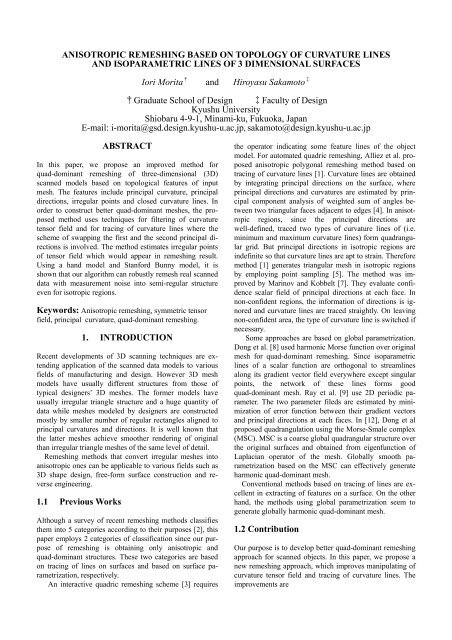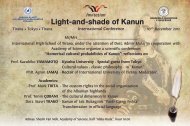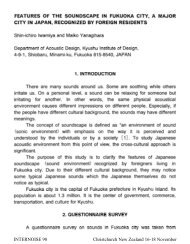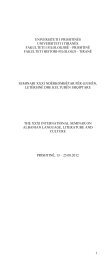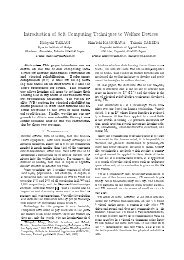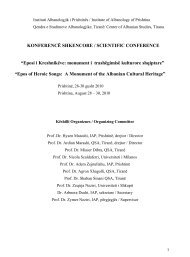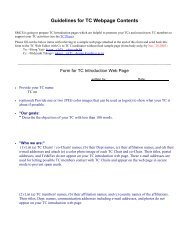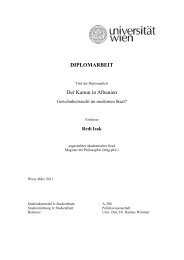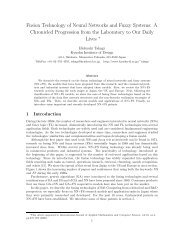SAMPLE OF A PROCEEDINGS PAPER:
SAMPLE OF A PROCEEDINGS PAPER:
SAMPLE OF A PROCEEDINGS PAPER:
Create successful ePaper yourself
Turn your PDF publications into a flip-book with our unique Google optimized e-Paper software.
ANISOTROPIC REMESHING BASED ON TOPOLOGY <strong>OF</strong> CURVATURE LINES<br />
AND ISOPARAMETRIC LINES <strong>OF</strong> 3 DIMENSIONAL SURFACES<br />
Iori Morita † and Hiroyasu Sakamoto ‡<br />
†Graduate School of Design ‡Faculty of Design<br />
Kyushu University<br />
Shiobaru 4-9-1, Minami-ku, Fukuoka, Japan<br />
E-mail: i-morita@gsd.design.kyushu-u.ac.jp, sakamoto@design.kyushu-u.ac.jp<br />
ABSTRACT<br />
In this paper, we propose an improved method for<br />
quad-dominant remeshing of three-dimensional (3D)<br />
scanned models based on topological features of input<br />
mesh. The features include principal curvature, principal<br />
directions, irregular points and closed curvature lines. In<br />
order to construct better quad-dominant meshes, the proposed<br />
method uses techniques for filtering of curvature<br />
tensor field and for tracing of curvature lines where the<br />
scheme of swapping the first and the second principal directions<br />
is involved. The method estimates irregular points<br />
of tensor field which would appear in remeshing result.<br />
Using a hand model and Stanford Bunny model, it is<br />
shown that our algorithm can robustly remesh real scanned<br />
data with measurement noise into semi-regular structure<br />
even for isotropic regions.<br />
Keywords: Anisotropic remeshing, symmetric tensor<br />
field, principal curvature, quad-dominant remeshing.<br />
1. INTRODUCTION<br />
Recent developments of 3D scanning techniques are extending<br />
application of the scanned data models to various<br />
fields of manufacturing and design. However 3D mesh<br />
models have usually different structures from those of<br />
typical designers’ 3D meshes. The former models have<br />
usually irregular triangle structure and a huge quantity of<br />
data while meshes modeled by designers are constructed<br />
mostly by smaller number of regular rectangles aligned to<br />
principal curvatures and directions. It is well known that<br />
the latter meshes achieve smoother rendering of original<br />
than irregular triangle meshes of the same level of detail.<br />
Remeshing methods that convert irregular meshes into<br />
anisotropic ones can be applicable to various fields such as<br />
3D shape design, free-form surface construction and reverse<br />
engineering.<br />
1.1 Previous Works<br />
Although a survey of recent remeshing methods classifies<br />
them into 5 categories according to their purposes [2], this<br />
paper employs 2 categories of classification since our purpose<br />
of remeshing is obtaining only anisotropic and<br />
quad-dominant structures. These two categories are based<br />
on tracing of lines on surfaces and based on surface parametrization,<br />
respectively.<br />
An interactive quadric remeshing scheme [3] requires<br />
the operator indicating some feature lines of the object<br />
model. For automated quadric remeshing, Alliez et al. proposed<br />
anisotropic polygonal remeshing method based on<br />
tracing of curvature lines [1]. Curvature lines are obtained<br />
by integrating principal directions on the surface, where<br />
principal directions and curvatures are estimated by principal<br />
component analysis of weighted sum of angles between<br />
two triangular faces adjacent to edges [4]. In anisotropic<br />
regions, since the principal directions are<br />
well-defined, traced two types of curvature lines of (i.e.<br />
minimum and maximum curvature lines) form quadrangular<br />
grid. But principal directions in isotropic regions are<br />
indefinite so that curvature lines are apt to strain. Therefore<br />
method [1] generates triangular mesh in isotropic regions<br />
by employing point sampling [5]. The method was improved<br />
by Marinov and Kobbelt [7]. They evaluate confidence<br />
scalar field of principal directions at each face. In<br />
non-confident regions, the information of directions is ignored<br />
and curvature lines are traced straightly. On leaving<br />
non-confident area, the type of curvature line is switched if<br />
necessary.<br />
Some approaches are based on global parametrization.<br />
Dong et al. [8] used harmonic Morse function over original<br />
mesh for quad-dominant remeshing. Since isoparametric<br />
lines of a scalar function are orthogonal to streamlines<br />
along its gradient vector field everywhere except singular<br />
points, the network of these lines forms good<br />
quad-dominant mesh. Ray et al. [9] use 2D periodic parameter.<br />
The two parameter fileds are estimated by minimization<br />
of error function between their gradient vectors<br />
and principal directions at each faces. In [12], Dong et al<br />
proposed quadrangulation using the Morse-Smale complex<br />
(MSC). MSC is a coarse global quadrangular structure over<br />
the original surfaces and obtained from eigenfunction of<br />
Laplacian operator of the mesh. Globally smooth parametrization<br />
based on the MSC can effectively generate<br />
harmonic quad-dominant mesh.<br />
Conventional methods based on tracing of lines are excellent<br />
in extracting of features on a surface. On the other<br />
hand, the methods using global parametrization seem to<br />
generate globally harmonic quad-dominant mesh.<br />
1.2 Contribution<br />
Our purpose is to develop better quad-dominant remeshing<br />
approach for scanned objects. In this paper, we propose a<br />
new remeshing approach, which improves manipulating of<br />
curvature tensor field and tracing of curvature lines. The<br />
improvements are
(1) propagating principal directions from characteristic<br />
curvature lines into isotropic regions,<br />
(2) a detection method of irregular points,<br />
(3) an extended tracing method of curvature lines with<br />
swapping principal directions,<br />
(4) searching and tracing methods of closed curvature<br />
lines.<br />
The propagating method aligns principal directions in<br />
isotropic regions with directions of characteristic lines of<br />
the shape. The detection method uses only anisotropic<br />
components of the curvature tensor in order of robust detection<br />
(section 2.2). The traced curvature lines from detected<br />
irregular points are important topological characteristics<br />
of the 3D shape.The extended tracing method exploits<br />
swapping of the 1st and the 2nd principal directions<br />
(section 3.1) in order to prevent crooking of lines and generate<br />
better quad-dominant meshes. Since closed curvature<br />
lines are important topological characteristics on models<br />
such as generalized cylinders, the approach uses 2D parametrization<br />
to search for closed lines (section 3.2).<br />
By these improvements, the proposed remeshing approach<br />
generates better quad-dominant remshes.<br />
2. ANALYSIS <strong>OF</strong> GEOMETRIC PROPERTY<br />
To trace curvature lines, we need to integrate the field of<br />
principal directions. In this chapter, we describe how to<br />
estimate principal curvature, direction and tensor fields and<br />
filtering of these fields. An original input mesh of our algorithm<br />
is an unstructured triangle mesh.<br />
2.1 Estimation of Curvature Tensor<br />
Let p be a vertex of original mesh with adjacent faces { f i |<br />
i = 1,…, M} and n-ring neighboring vertices { q i | i =<br />
1,…,N }. The face f i has barycentor f i and unit normal vector<br />
n(f i ). We estimate normal vectors at p from PCA of following<br />
matrix M.<br />
= ∑<br />
M 1<br />
T<br />
M ( p)<br />
n(<br />
fi)<br />
n(<br />
fi)<br />
(1)<br />
i 1 f p<br />
=<br />
i<br />
−<br />
where T means transpose. Among M(p)’s unit eigenvectors<br />
e 1 , e 2 , e 3 , normal vector at p is estimated by the nearest<br />
vector e 3 to the averaged normal vector n . The direction<br />
of e 2 is the cross product of e 1 and e 3 .<br />
n ( p)<br />
= e , e = e × e<br />
3 2 1 3<br />
The neighboring vertices q i are transformed to x i .<br />
T<br />
T<br />
x [ ] [ ]<br />
i<br />
= x<br />
i<br />
yi<br />
zi<br />
= e1 e2<br />
e3<br />
( qi<br />
− p)<br />
In order to estimate principal curvatures and directions,<br />
the following quadric surface f is fitted to the points x i to<br />
minimize the following error function E.<br />
1<br />
f ( x,<br />
y)<br />
= −<br />
2<br />
E =<br />
N<br />
2<br />
2<br />
( ax + 2bxy<br />
+ cy + d )<br />
∑( f ( xi<br />
, yi<br />
) − zi<br />
)<br />
i=<br />
0<br />
2<br />
(2)<br />
The 4 coefficients a, b, c, d are computed by linear equation.<br />
The associated shape operator matrix of f can be decomposed<br />
into rotation matrix and diagonal matrix of curvatures.<br />
⎡a<br />
⎢<br />
⎣b<br />
b⎤<br />
⎡ cosθ<br />
⎥ = ⎢<br />
c⎦<br />
⎣−<br />
sinθ<br />
sinθ<br />
⎤⎡κ1<br />
⎥⎢<br />
cosθ<br />
⎦⎣<br />
0<br />
0 ⎤⎡cosθ<br />
⎥⎢<br />
κ 2 ⎦⎣sinθ<br />
−sinθ<br />
⎤<br />
⎥<br />
cosθ<br />
⎦<br />
where κ 1 > κ 2 , θ is the signed angle between the 1st principal<br />
direction and e 1 . In addition, we define 4 principal<br />
directions including K 3 and K 4 .<br />
K1(<br />
p)<br />
= R(<br />
n(<br />
p),<br />
θ ) ⋅e1<br />
K 2 ( p)<br />
= K1(<br />
p)<br />
× n(<br />
p)<br />
K3(<br />
p)<br />
= −K1(<br />
p),<br />
K 4 ( p)<br />
= −K<br />
2 ( p)<br />
where R(n, θ ) is rotation matrix about axis n and signed<br />
angle θ . If the both of principal curvatures at p are equal,<br />
the p is an umbilic point (isotropic region). If |κ 1 ||κ 2 |, Κ 2<br />
and Κ 4 are directions of a ridge. We call these directions<br />
feature directions.<br />
The parameter field in a triangle face is obtained by linear<br />
interpolation of the parameters at the 3 vertices. The<br />
magnitude of anisotropy at p is shown by κ 1 (p) − κ 2 (p).<br />
2.2 Filtering of Curvature Tensor<br />
In this section, we smooth the fields of the principal curvatures<br />
and directions using curvature tensors. The principal<br />
curvatures and directions assigned on 3D surface are<br />
shown by second order symmetric tensor field.<br />
2.2.1 Smoothing<br />
3D principal directions {Κ j j = 1,…,4 } at p and its<br />
neighboring vertices should be embedded into tangent<br />
plane at p. Using the 1st principal directions Κ 1 (p) and<br />
Κ 2 (p) as basis vectors, the curvature tensor at p is<br />
⎡κ<br />
1(<br />
p)<br />
T(<br />
p)<br />
= ⎢<br />
⎣ 0<br />
0 ⎤<br />
κ ( )<br />
⎥<br />
2<br />
p ⎦<br />
The tensor T(p) is smoothed by averaging over neighboring<br />
vertices q i . In order to align coordinate axes of tensors<br />
T(q i ) with that of T(p), we determine rotation matrix<br />
E(α i,j ).<br />
⎡cosαi,<br />
j<br />
− sinαi,<br />
j ⎤<br />
E ( αi,<br />
j<br />
) = ⎢<br />
⎥<br />
(6)<br />
⎣sinαi,<br />
j<br />
cosαi,<br />
j ⎦<br />
where α i,j is signed angle between K 1 (p) and K j (q i ) which<br />
gives minimum absolute angle |α i,j | among j = 1,2,3,4. The<br />
curvature tensor at q i is computed as follows.<br />
( ) 0<br />
T<br />
⎡κ<br />
j qi<br />
⎤<br />
T( qi<br />
) = E(<br />
αi, j ) ⎢<br />
E(<br />
αi,<br />
j )<br />
0 κ j 1(<br />
qi<br />
)<br />
⎥ (7)<br />
⎣<br />
+ ⎦<br />
where the subscript j+1 is taken cyclical. The smoothed<br />
tensor field is computed by weighted average of T.<br />
∑i<br />
∑<br />
N<br />
i=<br />
1<br />
(3)<br />
(5)<br />
T(<br />
p)<br />
+ w<br />
=<br />
iT(<br />
q<br />
1<br />
i )<br />
T ( p)<br />
←<br />
(8)<br />
N<br />
1+<br />
w<br />
i<br />
where w i is 1 or a weight function such as Gaussian kernel.<br />
The method can compute a smoother tensor field and<br />
reduce the number of umbilic points. But we cannot obtain<br />
trustworthy curvature tensors over wide isotropic region by<br />
(4)
this smoothing process only, because the principal directions<br />
at isotropic region are sensitive to noise of small<br />
bumps and often show undesirable directions.<br />
2.2.2 Propagation of Principal Directions<br />
Our algorithm traces curvature lines along principal directions<br />
for anisotropic remeshing. Therefore ambiguous principal<br />
directions in isotropic regions often cause crooked<br />
curvature lines and irregular points of resulting mesh. In<br />
order to align the directions in isotropic region, the directions<br />
of feature lines in anisotropic region are propagated<br />
into neighboring isotropic regions.<br />
Procedure. We set two constant c 1 and c 2 where c 1 > c 2 ><br />
0. We pick up all vertices p where κ 1 (p)−κ 2 (p) > c 1 , then<br />
we trace curvature lines from each vertex toward both of<br />
forward and backward feature directions. Curvature lines<br />
are traced until κ 1 (x)−κ 2 (x)
3.1 Swapping of Curvature Directions<br />
In [1], curvature lines are traced based on integration of the<br />
1st and the 2nd principal directions separately. The method<br />
has problems that lines crook in regions such as waved<br />
surface where the 1st and the 2nd directions are switching.<br />
In order to reduce such crooking effects, we propose a<br />
method for swapping directions of line tracing.<br />
We use 4th-order Runge-Kutta mothod to trace a curvature<br />
line on a triangle mesh. From a start point specified on<br />
original mesh, we integrate vector field to trace a curvature<br />
line. If a curvature line crosses the edge between face f i and<br />
f j at p, we call the point p exit point of f i and entrance point<br />
of f j . The present algorithm stores a series of the points p as<br />
a curvature line.<br />
Each vertex of mesh has four principal directions K j<br />
(j=1,…,4). At each vertex of a triangle face f j , our method<br />
selects one of the four principal directions which has the<br />
closest direction to tangent vector d(p) at the entrance point.<br />
The vector field for integration is evaluated by linear interpolation<br />
of selected vectors at 3 vertices.<br />
3.2 Closed Curvature Lines<br />
Closed curvature lines are often regarded as important features.<br />
For example, a rotational model has closed circles on<br />
the surface. The closed curves on generalized cylinder can<br />
be exploited in various applications such as seamless texture<br />
mapping, detection of rotational axis and animation<br />
based on the skeleton.<br />
We detect closed curvature lines on surfaces as the first<br />
clue of forming network of lines. If a curvature line<br />
L + traced from a start points x 0 goes around the original<br />
mesh and approaches to x 0 again, we similarly trace L −<br />
from x 0 toward the counter directions of L + . If L − approaches<br />
similarly, we detect a closed curvature line based<br />
on the following parametrization procedure.<br />
Two parameter fields U + (q) and U − (q) are assigned to the<br />
neighbor regions of L + and L − , respectively.<br />
⎡<br />
+<br />
⎤ ⎡<br />
+<br />
T<br />
+ u ( q)<br />
length(L<br />
, x + ⎤<br />
0,<br />
xi<br />
) Wi<br />
Q<br />
U ( q)<br />
= ⎢ ⎥ =<br />
+ ⎢<br />
⎥ (16)<br />
⎣v<br />
( q)<br />
⎦ ⎢⎣<br />
( q − xi<br />
) ⋅ b(<br />
xi<br />
) ⎥⎦<br />
⎡<br />
−<br />
⎤ ⎡<br />
−<br />
T<br />
− u ( q)<br />
length(L<br />
, x + ⎤<br />
0,<br />
xi<br />
) Wi<br />
Q<br />
U ( q)<br />
= ⎢ ⎥ =<br />
− ⎢<br />
⎥ (17)<br />
⎣v<br />
( q)<br />
⎦ ⎢⎣<br />
− ( q − xi<br />
) ⋅ b(<br />
xi<br />
) ⎥⎦<br />
We compute averaged 2D parameter field U(q).<br />
⎡u(<br />
q)<br />
⎤<br />
⎡<br />
⎢ ⎥ = ⎢<br />
⎣v(<br />
q)<br />
⎦ ⎢<br />
⎣<br />
+<br />
−<br />
( u ( q)<br />
+ C − u ( q)<br />
)/<br />
2<br />
( ) ( ) ⎥ ⎥ ⎤<br />
+<br />
−<br />
+ v ( q)<br />
− v ( q)<br />
C − u ( q)<br />
+ C − u ( q)<br />
C<br />
C ⎦<br />
(18)<br />
where C is averaged circumference of L + and L − . If q does<br />
not belong to neighborhood of L − but L + , U(q) = U + (q), and<br />
vice versa.<br />
Isoparametric lines of parameter v(q) are closed lines on<br />
the surface. We employ the isoparametric line v(q) = 0 as a<br />
closed curvature line. We demonstrate an example of hand<br />
model in Fig.2. Closed curvature lines are detected on the<br />
wrist, thumb and fingers.<br />
Fig. 2: Closed curvature lines.<br />
3.3 Termination of Curvature Lines<br />
Our method terminates line tracing on some conditions in<br />
order to prevent the network from becoming too dense.<br />
Tracing of a curvature line stops where the line satisfies<br />
one of the following four conditions (1)-(4).<br />
While tracing j-th curvature lines L j , short curvature lines<br />
S i + and S i − are traced along both b(x i ) and −b(x i ) directions<br />
from x i where x i is a sampling point on L j . If S i + is intersected<br />
first by L k at the point y i , we call L k a neighbor line<br />
of L j . The conditions for terminating of the tracing process<br />
are,<br />
(1) the line is close to a predicted irregularity,<br />
(2) the line becomes longer than a constant,<br />
(3) the number of neighbor line k is equal to j,<br />
(4) the Euclid distance between y j and x j is smaller than<br />
following c(κ,ε).<br />
⎛ 2 ⎞<br />
1<br />
c ( κ,<br />
ε ) = 2 ε ⎜ − ε ⎟ , 0 < ε <<br />
(19)<br />
⎝ | κ | ⎠<br />
κ<br />
Here, ε is a tolerance based on distance between a straight<br />
line and an arc with radius |κ|, and κ is curvature corresponding<br />
to the bi-normal directions of L i .<br />
4. REMESHING USING NETWORK<br />
In this section, we describe how to grow the network of<br />
curvature lines. Curvature lines are increased by generating<br />
new lines from seed points spaced on lines already added<br />
to the network.<br />
4.1 Detection of Closed Lines<br />
In the first step, our algorithm searches the original mesh<br />
for strong anisotropic points as candidates of start points of<br />
closed lines and invests closed lines in the descending order<br />
of strength of anisotoropy. If a start points is immediate<br />
with existent closed line, it is excepted from candidates.<br />
In the second step, our algorithm traces curvature lines<br />
from the predicted irregular points. If neither closed lines<br />
nor irregular points are detected, curvature line traced from<br />
the strongest anisotropic vertex and adds the line to network.<br />
4.2 Growth of Network<br />
In the third step, our algorithm generates new lines from<br />
lines of former steps. Seed points are sampled on each line
of current network according to Eq.(19). Assuming J as the<br />
total number of lines, our algorithm follows the procedure<br />
described below.<br />
Procedure Firstly, seed points {x i } are put on the current<br />
line L j . The interval between x i and x i+1 is determined by<br />
c(κ,ε) and a ceiling. Secondly, new curvature lines are generated<br />
from each x i. From all x i , two lines are traced respectively<br />
along both b(x i ) and −b(x i ) directions until terminal<br />
points described in 3.3. If the sum of lengths of them<br />
is larger than a given constant, these lines are added to the<br />
network as L J+1 , then J is increased by 1. If the sum is<br />
smaller, these lines are deleted.<br />
We repeat this procedure from j = 1 until j reach to J.<br />
4.3 Elongation of Curvature Lines<br />
The terminal points of curvature lines cause irregular<br />
points (T-junction) in the resulting mesh. In order to reduce<br />
the number of irregular points and broader adjustment of<br />
the mesh, the curvature line L j is elongated until one of the<br />
following conditions is satisfied.<br />
(1) L j approaches to other terminal point of curvature line,<br />
(2) L j is close to one of detected irregular points.<br />
If the elongated part of a curvature line does not meet these<br />
conditions in a given constant length, the part is deleted. In<br />
Fig.3, the elongated parts of curvature lines are shown by<br />
thicker lines. The circles denote detected irregular points.<br />
5. EXPERIMANTAL RESULTS<br />
One of resulting network is shown Fig.5(a). The original<br />
data has 29,800 vertices. We set the tolerance ε and the<br />
ceiling to 0.01 and 0.2, respectively. In this experiment,<br />
number of vertices in remeshed data is 3,180. The back<br />
part of the hand model containes waved surface. Such a<br />
region cause crooked curvature lines by the conventional<br />
method [1] as shown in Fig.5(b). This algorithm can<br />
remesh such a region as regular as possible by swapping of<br />
directions.<br />
Figure 6 shows remeshing of Bunny model by proposed<br />
algorithm, where Fig.6(a) is the original unstructured<br />
mesh, and Figs. (b) and (c) are remeshed model rendered<br />
by the flat shading and the smooth shading, respectively.<br />
6. CONCLUSIONS<br />
In this paper, we propose a quad-dominant remeshing algorithm<br />
based on topology of curvature lines. This approach<br />
can construct better quad-dominant meshes by filtering of<br />
tensor fields and extended tracing of curvature lines. We<br />
plan experimentation about various input meshes to evaluate<br />
our methods. In addition, we consider introducing more<br />
interactive application.<br />
Fig. 3: Elongation of curvature lines<br />
4.4 Post-processing<br />
(a)<br />
Although our algorithm makes quadrangle faces from the<br />
network almost everywhere, terminal and irregular points<br />
form polygonal faces, besides quadrangle such as upper<br />
row of Fig.4 in the resulting mesh. In post-processing step,<br />
these faces are subdivided for quad-dominant remeshing.<br />
(b)<br />
Fig. 4: Post-processing of terminal<br />
and irregular points<br />
Fig. 5: Network generated by proposed algorithm(a)<br />
and conventional method(b)
Fig.6: Remeshing of Bunny model.<br />
REFERENCE<br />
[1] Alliez,P., Cohen-Steiner,D., Devillers.O, Levy,B.and<br />
Desbrun,M., "Anisotropic Polygonal Remeshing,"<br />
ACM Tras. Graphics, Proc. SIGGRAPH 2003, Vol. 22,<br />
pp. 485-493, 2003.<br />
[2] Alliez,P., Ucelli,G., Gotsman,C. and Attene,M., "Recent<br />
Advances in Remeshing of Surfaces.", in Shape<br />
Analysis and Structuring, ed. Floriani,L.D.and Spagnuolo,M.<br />
pp.53-82, Springer, 2008<br />
[3] Kanai.T, Suzuki.F, "An Interactive Remeshing method<br />
for uniform meshes", Visual Computing/Graphics and<br />
CAD, Joint Workshop ,pp.91-96, 2001 .<br />
[4] Cohen-Steiner,D. and Morvan,J.,”Restricted Delaunay<br />
triangulations and normal cycle.”, In Proc. ACM<br />
Symposium on Computational Geometry, pp.312-321,<br />
2003.<br />
[5] Alliez,P., Colin de Verdiere,E.Devillers,O. and Isenburg,M.,<br />
”Isotropic surface remeshing”,Procedings of<br />
Shape Medeling International, pp.49-58, 2003.<br />
[6] Surazhsky,V., Alliez,P. and Gotsman,C.,“Isotropic<br />
remeshing of surfaces, a local parametrization approach”<br />
In Proceedings of 12th International Meshing<br />
Roundtable, pp.215-224, 2003<br />
[7] Marinov,M. and Kobbelt,L., “Direct Anisotropic<br />
Quad- Dominant Remeshing”, Proc. Computer<br />
Graphics & Applications, pp.207-216, 2004.<br />
[8] Dong,S. Kircher,S. and Garland,M., “Harmonic functions<br />
for quadrilateral remeshing of arbitrary manifolds.”<br />
Computer Aided Geometric Design, 2005.<br />
[9] Ray,N., Li,W.C, Lévy,B., Sheffer,A. and Alliez,P., “Periodic<br />
Global Parameterization”, ACM Trans. Graphics,<br />
25, pp. 1460-1485, 2006.<br />
[10] Petitjean,S. “A Survey of Meshed for Recovering<br />
Quadrics in Triangle Meshes”, ACM Computing Survey,<br />
2, pp.1-61, 2002<br />
[11] Delmarcell,T. and Hesselink,L.,”The Topology of<br />
Smmetric, Second-Order Tensor Fields.”,Proc. IEEE<br />
Visualization Comf., pp.140-147, 1994<br />
[12] Dong,S., Bremer,R,T., Gerland,M.,Pascucci,V. and<br />
Hart,J,C., “Spectral Surface Quadrangulation”, ACM<br />
Tras. Graphics, Proc. SIGGRAPH 2006, Vol. 25, pp.<br />
1057-1066, 2006.


